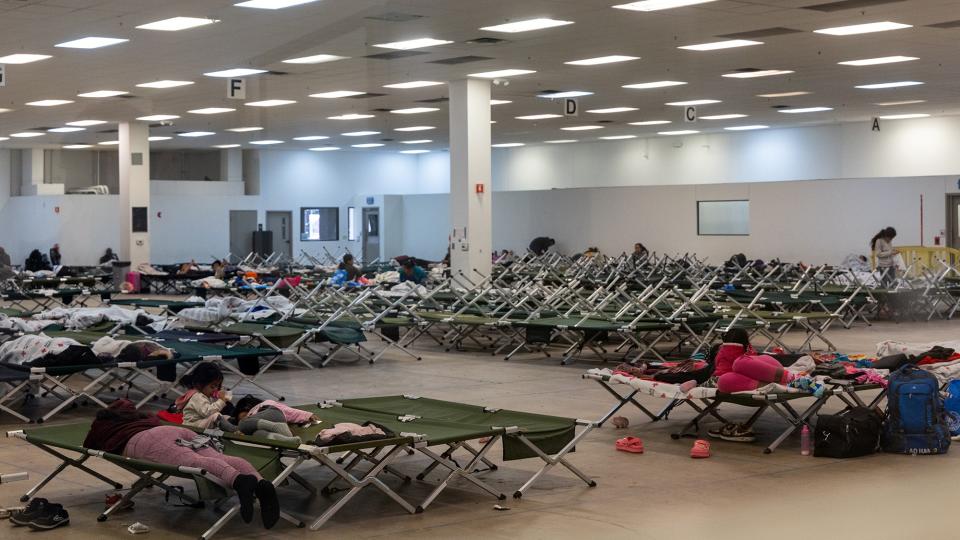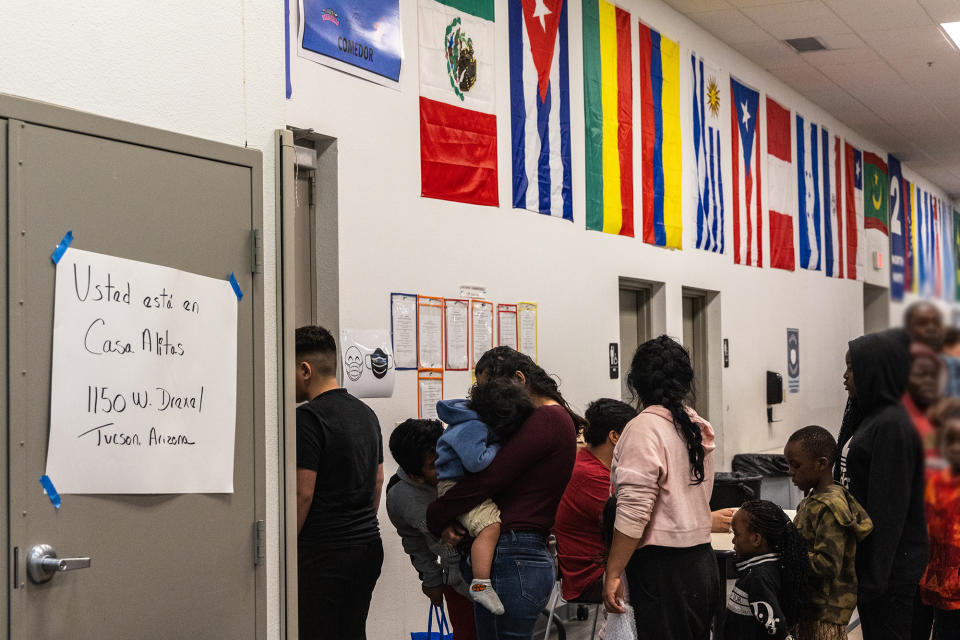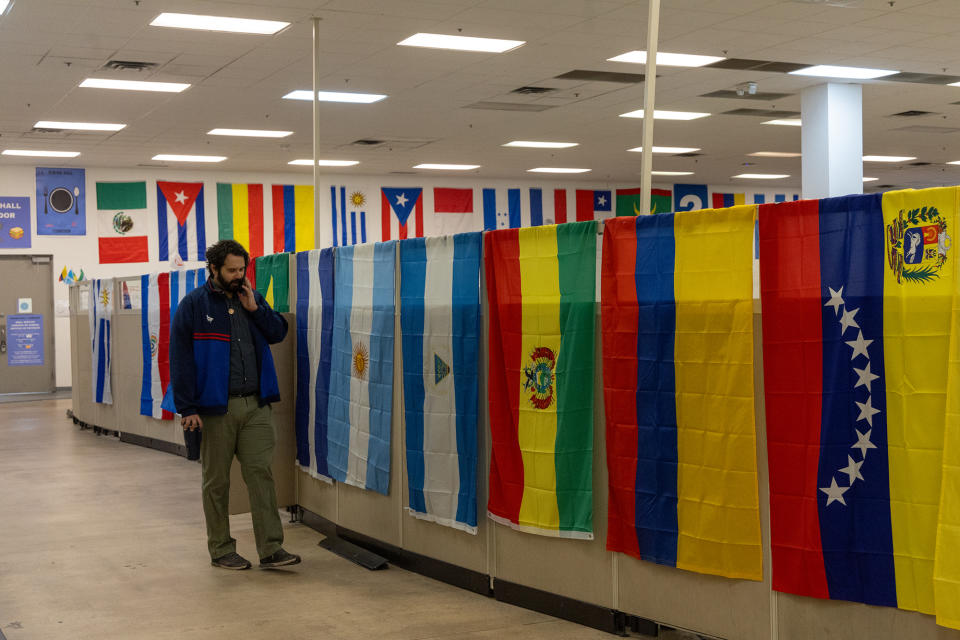Border shelters stave off ‘homelessness on steroids,’ but funding worries remain

A family gets out of a Customs and Border Protection van at the Casa Alitas shelter in Tucson, where they will wait to travel ot other parts of the country. (Photo by Lillie Boudreaux?Cronkite News)
TUCSON – A Customs and Border Protection van pulls to the side door of an industrial building. Two federal agents get out and open the van’s rear doors, revealing metal, barred gates that read “Inmate Transport.”
The first face to emerge from the van’s dark interior is a young girl wearing pink pants and a beaming smile. A man steps out next and carries her, and her juice box, toward the entrance of the shelter where asylum seekers get food, clothes, and a temporary shelter after being processed by CBP and released from Immigration and Customs Enforcement detention.
The scene is repeated daily at the Casa Alitas shelter in Tucson where hundreds – sometimes thousands – of asylum seekers, many of them young children, are dropped off with little more than the clothes on their backs.
Without shelters like this, migrants would just be released on the streets and Tucson would experience “homelessness on steroids,” one Pima County official has said.
“He would’ve been on the streets,” Casa Alitas Director Diego Lopez said on a recent morning, pointing to a young boy in a group of others in the shelter. “Any child here in this room that is above the age of 3 would’ve been on the streets in Tucson. … If we had no resources or space, they would have been dropped off at the Greyhound bus station.”
GET THE MORNING HEADLINES DELIVERED TO YOUR INBOX
That situation came perilously close to becoming reality this spring, when political infighting in Washington nearly let funding lapse for FEMA’s Shelter and Services program, which funds services for migrants who are awaiting their immigration hearings.
The program got a last-minute reprieve when Congress passed a $1.2 trillion budget in late March that included $650 million for the shelter program – $55 million of which went to programs in Arizona.
Lopez called congressional approval of the funding a “pinch me I’m dreaming” moment. But that quickly gave way to concerns that they came so close to losing funding, and fears that they will face the same situation when this round of funds runs out.
“I’m still processing the information, but at the same time I know I have to work with the team to direct the ships and make sure that we prepare ourselves so … the blow, if this happens again, it’s less for us,” he said.

Even when the funding was approved, there were weeks of uncertainty over how much Pima County would get. County Administrator Jan Lesher said in March that if the county got $12 million, as it did last year, that would only fund services for about three months. In April, the county learned it would get $21.8 million – enough to “sustain sheltering operations through the remainder of 2024, depending on the fluctuation in border crossings,” she said.
Pima County’s allocation was the largest in the state. Other funding went to Maricopa County, which will get $11.6 million, and the nongovernmental organization World Hunger Ecumenical Arizona Task Force, which will receive $21.1 million for operations in Maricopa and Yuma counties.
Pima County directly funds nonprofits like Catholic Community Services, which runs Casa Alitas, for direct services. But it also used $6.2 million in federal and state funds last year to purchase the 60,000-square-foot building on Drexel Road where Casa Alitas operates the largest of its three shelters. That purchase included funding from the state’s Border Security Fund and from the federal American Rescue Plan Act.
Even though Pima County will get significantly more than it did last year, it comes at a time when demand is significantly higher.
“We’ve had lines outside the building for families to wait in tents because the need was so high,” said Lopez, adding that the organization receives as many as 1,800 asylum seekers daily across all its shelter locations.
RK Kelly, the director of Pima County Grants Management and Innovation, said in a March interview that the cost of providing food, shelter, and transportation to asylum seekers in Pima, Cochise, and Santa Cruz counties had been about $1 million a week since September, when border crossings were surging.
When encounters in the Tucson sector reached an all-time high in December, Casa Alitas served 32,898 asylum seekers, more than 11,000 of whom were children. In March, they assisted 12,034 people and more than half were children.

Lesher said in a letter to county officials in February that the program has “prevented a humanitarian crisis from occurring daily” that would be caused by “having hundreds of people with limited resources and English-language skills released onto city streets every day.”
Without federal funding, Lopez said, Casa Alitas would have to close down the large Tucson shelter and a smaller Nogales location, and limit intakes to only 140 asylum seekers a day. The stress has eased somewhat, with the shelter was receiving about 500 people a day in April, but Lopez said the rapid fluctuations in intake cause the organization to burn through money faster, making it difficult to plan for what is needed.
“When the numbers fluctuate so high, the burn rate goes exponentially higher,” he said. “That’s one of the challenges, I think, that we faced before … we had the burn rate go up, the numbers go from what we projected at about 750 people a day to 1,500 people a day, so we had to adjust a lot of strategies and plans.”
When funding was in doubt, Casa Alitas prepared for a complete shutdown of sheltering and transportation assistance systems, telling more than 30 staff members to begin looking for new jobs and looking to rely on volunteers to keep services afloat. Kasey Fry, the volunteer coordinator for Casa Alitas, said there are currently more than 200 volunteers who help make travel arrangements, do laundry, serve food, organize donations and help with children’s activities.
“It was a concern,” Fry said of the possible shutdown. “Luckily, me and like the other volunteer coordinator, were left out of that … I think with the intention that if we lost all our, almost all of our staff, we would rely extra heavily on volunteers.”
“I was a skeptic, I really thought the funding wasn’t going to pass. I was very surprised and grateful that it passed but yeah, it happened at the very last minute,” she said. “We were preparing to basically lose this building and downsize into our welcome center.”

Even with renewed federal funding now secured, Lopez said he is still considering closing the other locations to make that funding last longer. But that could present more challenges if numbers increase again in the following days, weeks or months.
After processing migrants, CBP releases them with orders to appear for their asylum hearings – which can take years. In the meantime, asylum seekers are often taken to shelters where they wait for buses to take them to Sky Harbor International Airport in Phoenix for flights to their final destinations – most often California, New York, Texas, Florida and Georgia, Lopez said.
Half of the migrants that Casa Alitas receives are dropped off by CBP agents directly, others are bused from Santa Cruz and Cochise counties through a state-run program.
When they feared the loss of federal funds, Pima County in February proposed dropoff locations other than the Greyhound station, including the Pima Fairgrounds or the Mission Facility outside the county jail. But those proposals would not have kept pace with the number of migrants being released from detention daily and would have cost local taxpayers at least $125,000 a month. Lesher rejected the alternatives, saying the county has “done all we can for five years.”
“It is severely frustrating and disappointing that we are in this situation,” Lesher’s February letter said. “This is a crisis of the federal government’s making due to the failure to pass sensible border and immigration reform and to provide the necessary funding to local jurisdictions forced to deal with the deleterious effects of federal border policy.”
Supervisor Steve Christy said in an April Board of Supervisors meeting that Lesher’s decision to get out of what he called the “aslyum-seeking business” was “refreshing.”
“Now would be a perfect time where we can start to wean ourself off this addiction of enabling and that we can search for ways that Pima county can extricate itself from this terrible addiction of providing asylum for migrants coming into this county,” said Christy, a Republican.
He said he worries they will end up in this situation again, panicked about the possible loss of federal funding for a program he said “we shouldn’t be doing.”
“The effort doesn’t need to be helped with more funding, it needs to be helped with government intervention at the border before the migrants even step foot in this county,” Christy said.
Supervisor Adelita Grijalva, a Democrat, pushed back, saying that without “comprehensive immigration reform that nobody has wanted to touch for decades – we’re going to continue to have the situation.”
“Whether we’re providing this service through Casa Alitas or not, people are going to come,” Grijalva said. “All we’re doing is helping them to get to their final destination and not have that be in a prolonged stay in Pima County, which would then become a major issue for all of us.”

At its main Tucson shelter, Casa Alitas has more than 600 beds for individuals and families, a storage room filled with donated shoes and clothing, intake areas, and a cafeteria where volunteers pour coffee and serve food for migrants waiting to head to their final destinations. The nonprofit also runs a welcome center in Nogales.
Lopez said his biggest concern about a loss of funding was the potential “human suffering” of migrants who would be left on the streets without resources and the impact on Tucson.
“If you’re having people dropped off who haven’t eaten, who have no phone charge, have no language, no cultural background, I think the challenges of going to local businesses, using the restrooms and so forth, safety concerns is just exponentially higher and the cost to the communities will grow,” Lopez said.
“And that’s not only here in Tucson. That will be in Nogales, Douglas, and for sure Phoenix will have to deal with some of those consequences,” he said.
Whether the shelter service is funded or not, Lopez said he does not expect demand to ease, as living conditions and safety concerns in migrants’ home countries lead more to seek asylum in the United States.
“I wish people understood, none of the people who we are serving at Casa Alitas are ‘illegals’ as some will say, they’re all processed asylum seekers. They’re going through the asylum process,” he said.
He said they come from many different countries but share a desire to be free, to “just be a person and be recognized as a person. I think a lot of times we take for granted those values that we have in this country and think that it’s shared across the globe.”
The post Border shelters stave off ‘homelessness on steroids,’ but funding worries remain appeared first on Arizona Mirror.

